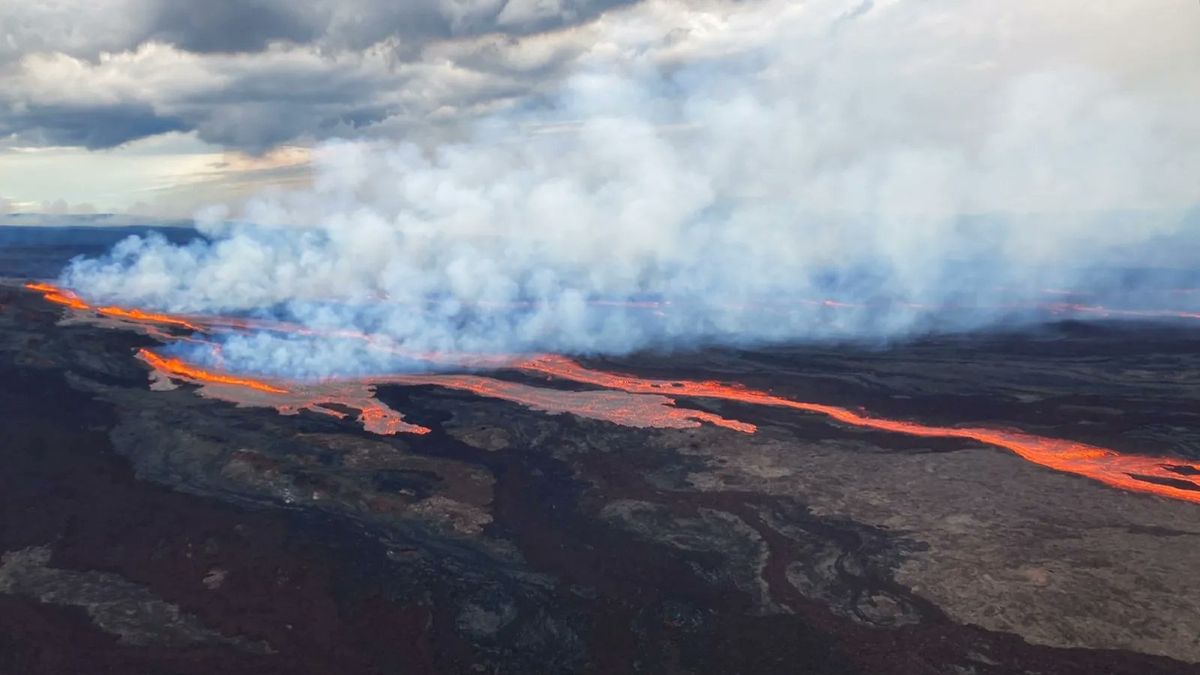The lava flows from the third fissure of the great crater reached a speed of up to 40 meters per hour in the last day, the United States Geological Survey (USGS) reported this Friday, before slowing down.
In their most recent report, the authorities detailed that lava is located 5.2 kilometers from the important highway Daniel K. Inouye (Saddle Road) and that, according to what has been observed in the last few hours, the lava river could reach this transit artery in a week.
“However, there are many variables at play and both the direction and timing of the flow are fluid and are expected to change over periods of hours to days,” they clarified.
The Service noted that the third fissure is the one that emanates the largest lava flows, while the first two feed the rivers down the slope. The fourth fissure spews out flows of this fiery matter that move to the northeast. At the moment, no property is under threat from the phenomenon, the USGS highlighted.
Specialists warn that the winds can carry volcanic gas, fine ash and strands of basalt glass known as Pele’s hair down the hill. These threads, which can measure up to two meters, are formed when skeins of lava cool rapidly in the air.
They were named after Pele, the goddess of volcanoes in Hawaii. They can be very sharp and pose a potential eye and skin injury hazard.
mauna loa (“Big Mountain”) is the largest volcano on Earth by surface area and covers half of the Big Island, making it larger than the rest of the Hawaiian Islands combined.
Mauna Loa: its awakening in 2022
The first signs of activity were known to beginning of October 2022, when the US Geological Survey revealed a tenfold increase in the meters of small earthquakes present, below the volcano’s summit caldera. This has to do with the underground movements of the magma inside the volcano.
The brief but constant earthquakes remained sporadic until November 27, 2022, when new fissures began to be seen on the crater surface. Around 11:30 p.m. local time, these tears presented some lava spills.
Muna Loa volcano hawaii (1).jpg
On November 28, there was a part of the cloud layers, which scattered the light from the eruption and made it impossible to see it from the urban areas of the island. “It appears that the lava emitted from the eruption was so bright that the sensor became saturated, producing a ‘post-saturation recovery streak’ to the southeast,” Simon Carn, a Michigan Tech volcanologist, said in a NASA Earth Observatory statement. “These streaks are only seen over very intense sources of visible radiation,” he finally added.
Among the substances that the volcano emanated were sulfur dioxide (SO2), which is an acrid gas that reacts with oxygen and water to form a gray volcanic mist, called “vog.”
“The eruption is effusive rather than explosive, although its initial phase overnight on November 28 was quite energetic, injecting some high-altitude sulfur dioxide, possibly up to the tropopause,” Carn said, which he said is “unusual.” for this type of eruptions”.
“Mauna Loa eruptions typically last a few weeks,” NASA Jet Propulsion Laboratory volcanologist Ashley Davies said, adding that this is “an evolving eruption and we’re only in the early days.”
Source: Ambito
David William is a talented author who has made a name for himself in the world of writing. He is a professional author who writes on a wide range of topics, from general interest to opinion news. David is currently working as a writer at 24 hours worlds where he brings his unique perspective and in-depth research to his articles, making them both informative and engaging.




